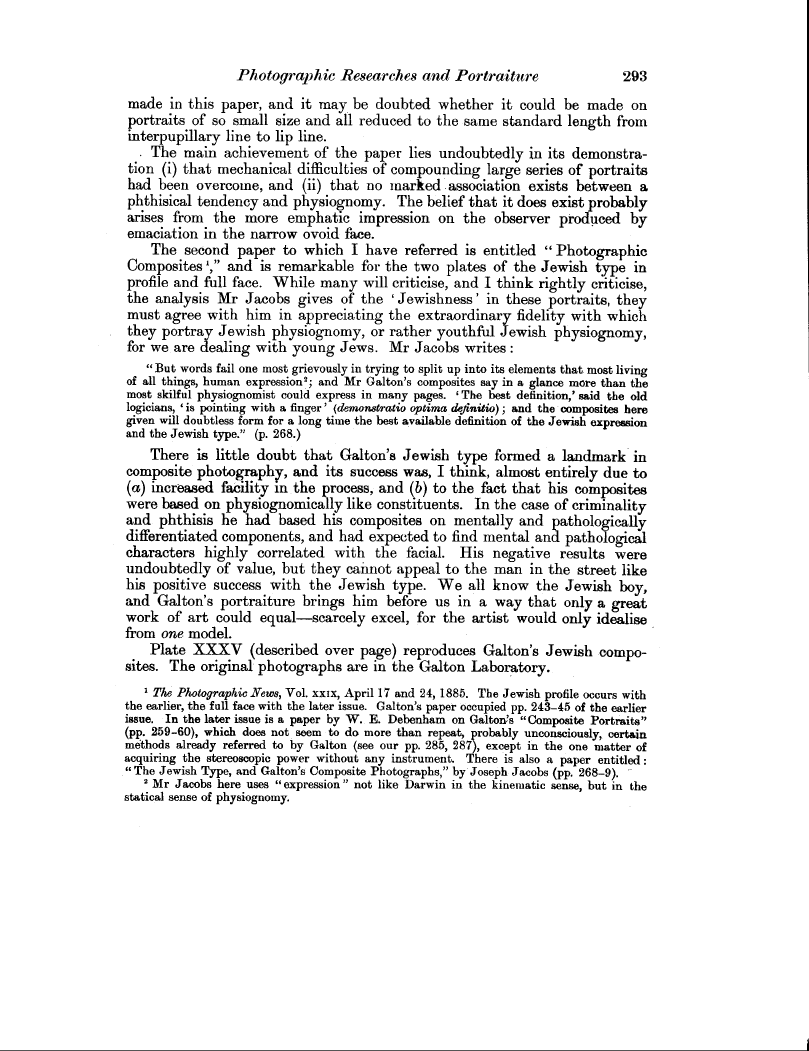Photographic Researches and Portraiture 293
made in this paper, and it may be doubted whether it could be made on portraits of so small size and all reduced to the same standard length from interpupillary line to lip line.
. The main achievement of the paper lies undoubtedly in its demonstration (i) that mechanical difficulties of compounding large series of portraits had been overcome, and (ii) that no marked association exists between a phthisical tendency and physiognomy. The belief that it does exist probably arises from the more emphatic impression on the observer produced by emaciation in the narrow ovoid face.
The second paper to which I have referred is entitled " Photographic Composites'," and is remarkable for the two plates of the Jewish type in profile and full face. While many will criticise, and I think rightly criticise, the analysis Mr Jacobs gives of the ' Jewishness ' in these portraits, they must agree with him in appreciating the extraordinary fidelity with which they portray Jewish physiognomy, or rather youthful Jewish physiognomy, for we are dealing with young Jews. Mr Jacobs writes
"But words fail one most grievously in trying to split up into its elements that most living of all things, human expressions; and Mr Galton's composites say in a glance more than the most skilful physiognomist could express in many pages. ' The best definition,' said the old
logicians, ' is pointing with a finger' (demonstratio optima definitio); and the composites here given will doubtless form for a long time the best available definition of the Jewish expression and the Jewish type." (p. 268.)
There is little doubt that Galton's Jewish type formed a landmark in composite photography, and its success was, I think, almost entirely due to (a) increased facility in the process, and (b) to the fact that his composites were based on physiognomically like constituents. In the case of criminality and phthisis he had based his composites on mentally and pathologically differentiated components, and had expected to find mental and pathological characters highly correlated with the facial. His negative results were undoubtedly of value, but they cannot appeal to the man in the street like his positive success with the Jewish type. We all know the Jewish boy, and Galton's portraiture brings him before us in a way that only a great work of art could equal-scarcely excel, for the artist would only idealise from one model.
Plate XXXV (described over page) reproduces Galton's Jewish composites. The original photographs are in the Galton Laboratory.
I The Photographic News, Vol. xxix, April 17 and 24, 1885. The Jewish profile occurs with the earlier, the full face with the later issue. Galton's paper occupied pp. 243-45 of the earlier issue. In the later issue is a paper by W. E. Debenham on Galton•s "Composite Portraits" (pp. 259-60), which does not seem to do more than repeat, probably unconsciously, certain methods already referred to by Galton (see our pp. 285, 287), except in the one matter of acquiring the stereoscopic power without any instrument. There is also a paper entitled "The Jewish Type, and Galton's Composite Photographs," by Joseph Jacobs (pp. 268-9).
2 Mr Jacobs here uses "expression" not like Darwin in the kinematic sense, but in the statical sense of physiognomy.

